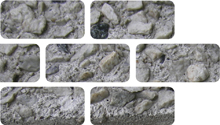
Wastes Containing Nanoparticles Hazardous 16 03 03
Nanomaterials and nanostructured materials (nanoparticles, nanofibres, nanopowders, nanotubes, nanowires) are microscopic materials only a few nanometres in diameter which is 1/50,000th the width of a human hair and invisible to the human eye. They are increasingly being used in the manufacture of certain construction products, mechanical equipment and electrical appliances. As an example, carbon nanotubes are cylindrical nanoparticles used in the production of some concrete products which provide very high tensile strength, excellent electrical conductivity and can withstand high working temperatures. When the buildings or structures reach their end of life, wastes containing unbound carbon nanotubes (nanomaterials) may be generated during the demolition of buildings, crushing of concrete or processing of recycled aggregates. These wastes containing unbound carbon nanotubes at concentrations above 0.1% are mirror hazardous wastes and need appropriate and specialist treatment and handling.
Usage & Probable Locations
Nanomaterials have been used in the manufacture or improvement of certain products including metals, polymers, coatings, pigments, ceramics, nano-electronic devices, electronics, photovoltaics, composites and concrete. Nanomaterials significantly improves material performance including tensile strength, electrical conductivity, interface properties and structural integrity. They will be increasingly found in domestic, commercial and industrial buildings in a wide range of applications, fixtures and equipment including walls, roofs, floors, panel systems, piping, equipment and appliances.
Personal Protective Equipment
PPE requirements indicated are for guidance purposes only. DRIDS has identified the PPE that is mandatory on all demolition projects and ones that may be required subject to site specific Risk Assessment & Method Statement (RAMS). Hover over the icon to determine the types of PPE required for the removal of this material.
Removal, Segregation & Storage
Wastes containing unbound nanomaterials destined for landfill should only be removed by appropriately trained staff or approved, specialist contractors. They are to be carefully deconstructed, segregated and stored safely according to strict guidelines and protocols. Arrangements should be put in place to ensure that all control measures defined in 'BSI Guide to safe handling and disposal of manufactured nanomaterials' are properly and fully applied. They should also be removed from site in accordance with HSE legislation with the appropriate RPE/PPE as defined by RAMS.
Tools
Fixtures, Fittings & Connections
Construction products, equipment and appliances containing nanomaterials may be fixed in place with screws, nails, bolts, mortar, mastic, glues, adhesives or other binding agent. Some require no fixings, may be a cast product like concrete or they may have been placed within cavities, between other products or manufactured within products, equipment or appliances.
Health & Safety
Subject to task-specific Risk Assessment & Method Statement (RAMS). A specific issue relates to comparisons between high aspect ratio nanomaterials (e.g. some carbon nanotubes or nanowires) and asbestos, so a suitably cautious approach should be taken in their handling and disposal. Only handle wastes containing unbound nanomaterials if appropriately trained, or use specialist contractors. Wear appropriately assessed clothing, gloves, eye protection and respiratory protective equipment when handling wastes containing unbound nanomaterials to prevent inhalation, ingestion, dermal exposure, irritation and abrasion. Use eye protection when using hand tools. Use appropriate access and protective equipment determined by RAMS.
Further reading
- BSI Terminology for Nanomaterials
- HSE Nanoparticles: An occupational Hygiene Review
- OECD List of Manufactured Nanomaterials
- OECD Guidance Manual Testing of Manufactured Nanomaterials
- OECD Selection of Protective Equipment and Respirators for Manufactured Nanomaterials
- BSI Guide to safe handling and disposal of manufactured nanomaterials
- NetRegs - Managing your hazardous/special wastes
















